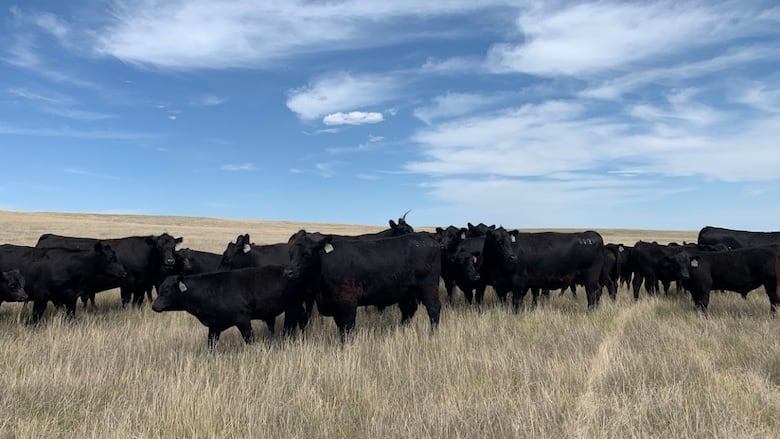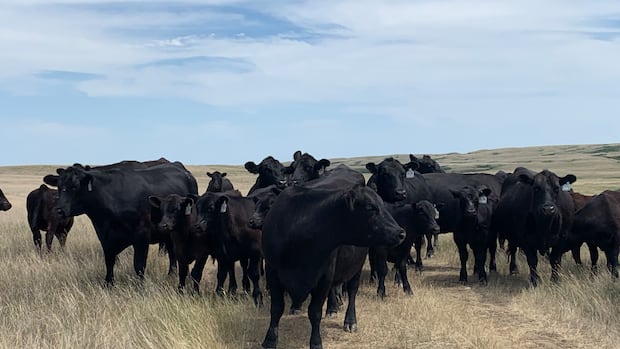'Nothing grew': 4 southwest Sask. municipalities declare states of emergency due to drought
RMs of Maple Creek, Fox Valley, Enterprise and Waverley all made the declarations

Several rural municipalities (RMs) in southwest Saskatchewan have declared states of emergency due to drought.
The RMs of Maple Creek, Fox Valley, Enterprise and Waverley all say the lack of moisture poses a high fire risk and that many farmers are struggling to make feed for their livestock.
"This spring has been the worst drought that we've lived through in our 33 years," said Corinne Gibson, who owns Six Mile Ranch near Fir Mountain, Sask., with her husband Clayton.
Corinne said it was clear by early May that their 4,500-hectare ranch was "in trouble" from the lack of moisture.
"Nothing even started, nothing grew," Corinne said.
They started seeding their crops over the May-long weekend.
Four weeks later, "it couldn't grow anymore. It was just trying to stay alive, but it couldn't get any taller," Clayton said.
He said their crops only grew to be six to eight inches tall this year.
Crops are usually cut and baled or made into silage to feed cattle over the winter, but in this case "that's not existent," Corinne said.
As a result, the majority of the cattle have been moved to their hay land to graze the small amounts of grass left over from last winter. Other feed has to be purchased from other farms.
"Financially it's challenging," Corinne said. "We're talking hundreds and hundreds of thousands, if not closer to $1 million, for us to replace all of that feed that we would normally produce ourselves."
With only two bouts of rain this season, the Gibsons are now having to take more drastic measures to feed their livestock. Corinne said they have transported around 200 cattle to a farm in Weyburn, where there is more grass available. She said a move like that is risky.
"Hauling those cattle those 300 kilometres, you know, we risk them losing their pregnancies because they are bred females," she said, adding that those long trips are extremely stressful for the animals.

The Gibsons aren't the only ones who have had bad production this year. Corinne said many of the producers in her community have "wasted" a large amount of their seeds, fertilizers and chemicals due to the drought.
"You have to be resilient as a farmer," Corinne said. "But we don't know how many more years of this kind of situation that a lot of our neighbours and friends can actually live through."
Government provides crop insurance
The Saskatchewan Crop Insurance Corporation (SCIC) will be implementing a double low-yield appraisal process this year to support Saskatchewan producers impacted by poor weather conditions. It is also encouraging low-yielding eligible crops to be diverted to make additional feed available for silage, grazing or bales.
"I fully realize the dry conditions [producers] are going through," Saskatchewan Agriculture Minister Daryl Harrison said.
Minister Harrison said the new low-yield threshold will allow producers to salvage the crops they do have.
"That's important feed that livestock producers will require in these dry conditions," he said.
Rainfall insurance is also available to eligible producers, with payments expected as early as mid-July.
Harrison said these types of business risk management programs are always a "first line of defence," but that the government can make changes.
"We're always open to hearing producers' concerns," he said. " We'll be here to support producers."
Latest crop report
The province's latest crop report, released Thursday, says many areas in the southern parts of the province have received limited rainfall, putting further stress on crops.
The report found that all crops have developed ahead of "normal stages," even more than last week's report. It said about half of the fall and spring cereal crops are in good condition, with most of the other half in fair to poor condition.
On the other hand, for pulse crops and "most" oilseed crops, more than half were in fair to good condition as of the end of June.

Many producers have reported that dry conditions, heat and wind are causing the most damage to crops in the province, the report said.
"More timely rain will be needed throughout July and August to sustain yield potential to harvest," the report says.


